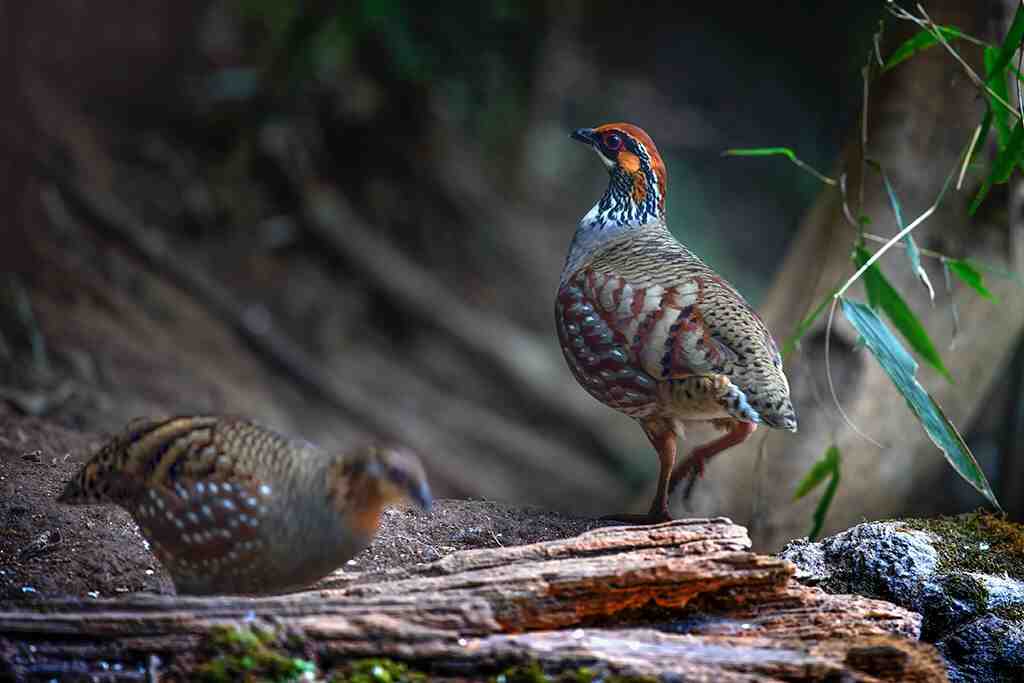Arborophila torqueola
IUCN
LCBasic Information
Scientific classification
- name:Arborophila torqueola
- Scientific Name:Arborophila torqueola
- Outline:Landfowl
- Family:Galliformes Phasianidae Partridge
Vital signs
- length:26-39cm
- Weight:261-430g
- lifetime:5-7years
Feature
There is a white horizontal band between the front neck and the chest that separates the neck and chest, hence the name.
Distribution and Habitat
Distributed in Vietnam, Bhutan, China, India, Lao People's Democratic Republic, Myanmar, Nepal and Vietnam.
In China, it is distributed from the Himalayas to the southeastern part of Tibet in western China, and in Tengchong, Yongde, Longling, Lushui, Gongshan and Jingdong in Yunnan.
The ring-necked mountain partridge lives in evergreen broad-leaved forests above 1,500 meters above sea level, especially in oak forests, bamboo forests, and dense evergreen forests in mountain streams and valleys with rich understory vegetation, open forests or blocks and patches. Sometimes it can reach evergreen forests and shrubs at an altitude of about 4,200 meters.
Appearance
The male Ring-necked Mountain Quail has a deep chestnut forehead, top of the head and nape, black eyes, cheeks and eyebrow stripes; it has a wide and long black eyebrow stripe that extends all the way back to the nape. The ear feathers are brown chestnut and extend back to the sides of the neck. The upper body is olive brown from back to tail, with a black half-moon spot on the back, and black arrow-shaped or triangular spots on the waist and tail coverts; the shoulders and inner coverts have broad chestnut feather edges and black sub-terminal spots; the primary flight feathers are dark brown, with narrow light chestnut feather edges at the rear end of the outer vanes; the secondary flight feathers are black-brown, with chestnut edges on the outer vanes and decorated with black-brown spots; the tertiary flight feathers are brown-brown, with chestnut feather bases and feather tips, and black sub-terminal spots. The chin and throat are black with white stripes, especially the white strip
Details
Hill Partridge, there are 5 subspecies.

Hill Partridge is a resident bird. They often move in pairs or small groups of 3-5 or family groups. They are alert and good at hiding. They run fast on the ground. When frightened, they often run to escape from enemies. They only take off when they are in danger or have no choice, but they fall down after flying a short distance and quickly escape into the grass, bushes or bamboo bushes.
The call of the Ring-necked Mountain Partridge is a sad whistle, repeated several times, followed by 3-6 double whistle sounds do-eat, do-eat, and the call rises higher and higher like a hawk cuckoo. Sometimes it is a loud and crisp "squeak-squeak" double sound similar to the sound of a vibrating string. When singing duet, if the female bird makes a kwik, kwik, kwik, kwik, kwik call, the male bird will respond with a series of do-eat calls, which suddenly stop after the climax.
Ring-necked mountain quail mainly feeds on leaves, roots, buds, berries and seeds of shrubs and herbs, as well as insects and various small invertebrates. It usually digs for food in places with thick leaf litter under the forest, and makes a long "cluck, cluck, cluck..." sound similar to that of domestic chickens while digging for food.
The breeding season of ring-necked mountain quail is from April to June. It nests on the ground under the forest in mountain forests between 1500 and 4000 meters above sea level. The nest is mainly made of natural pits on the ground or a small pit dug by the female bird on the ground. The nest is often covered by lush shrubs or understory plants and is not easy to find, but sometimes it also nests in places where the understory plants are sparse and not very hidden. Each nest lays 3-5 eggs. The eggs are pure white and oval in shape. The average size of the eggs is 40.6×31.9 mm, the largest is 44.2×33.6 mm and 43.8×34.0 mm, and the smallest is 35.6×28.7 mm and 35.8×27.4 mm. The female bird is mainly responsible for incubation, and the male bird guards and assists the female bird in incubating and caring for the chicks. The chicks are precocial and can walk and follow the activities of the parents soon after hatching. The incubation period is 24 days.
The distribution range of the ring-necked mountain partridge is wide, and it is not close to the vulnerable and endangered critical value standard for species survival (distribution area or fluctuation range is less than 20,000 square kilometers, habitat quality, population size, and fragmented distribution area). The population trend is stable, so it is evaluated as a species without survival crisis.
Listed in the "National List of Terrestrial Wildlife with Important Economic and Scientific Research Value" (Item 87) issued by the State Forestry Administration of China on August 1, 2000.
Listed in the "Red List of Endangered Species of the World Conservation Union" (IUCN) 2016 ver 3.1-Least Concern (LC).
Listed in the second level of China's "National Key Protected Wildlife List" (February 5, 2021).
Protect wild animals and stop eating game.
Maintaining ecological balance is everyone's responsibility!








